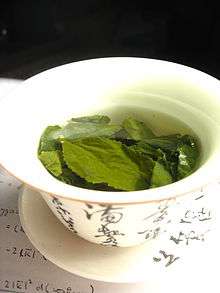Steeping

Steeping is the soaking in liquid (usually water) of a solid so as to extract flavours or to soften it. The specific process of teas being prepared for drinking by leaving the leaves in heated water to release the flavour and nutrients is known as stewing. Herbal teas may be prepared by decoction, infusion, or maceration. Some solids are soaked to remove an ingredient, such as salt from smoked ham or salted cod, where the solute is not the desired product.
Corn
One example is the steeping of corn (or maize), part of the milling process. As described by the US Corn Refiners Association, harvested kernels of corn are cleaned and then steeped in water at a temperature of 50 °C (120 °F) for 30 to 40 hours.[1] In the process their moisture content rises from 15% to 45% and their volume more than doubles. The gluten bonds in the corn are weakened and starch is released. The corn is then ground to break free the germ and other components, and the water used (steepwater), which has absorbed various nutrients, is recycled for use in animal feeds.
Tea
Dried teas as loose tea or tea bags are prepared for drinking by steeping the leaves in just boiled or heated water to release the flavour and nutrients in the dried tea into the water. This is often done in a cup, mug, teapot, pitcher or urn. A tea infuser or a tea strainer may be used to assist in this process.
Beer
Steeping grain is a part of beer making.
See also
References
- ↑ "Corn steeping". www.Corn.org. Archived from the original on June 13, 2005. Retrieved June 20, 2005.